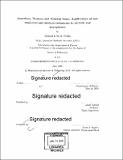Neutrinos, neurons and neutron stars : applications of new statistical and analysis techniques to particle and astrophysics
Author(s)
Collin, Gabriel L.W.H
DownloadFull printable version (22.01Mb)
Alternative title
Applications of new statistical and analysis techniques to particle and astrophysics
Other Contributors
Massachusetts Institute of Technology. Department of Physics.
Advisor
Janet Conrad.
Terms of use
Metadata
Show full item recordAbstract
The IceCube detector opens a new window into our universe; valuable for both astronomy and particle physics. This thesis spans a wide range of topics that are bound together by a common theme: the development and application of new statistical and computational methods for analysing data from particle and astrophysics experiments. Sterile neutrinos are a hypothetical fourth kind of neutrino, which are motivated by anomalies observed in various short base-line neutrino experiments. These experiments have published results that are not mutually compatible. This thesis presents a global fit to many short base-line datasets with the addition of the recent IceCube sterile neutrino search, constraining the full 3+1 mixing matrix for the first time. The global fit strongly favours the sterile neutrino hypothesis, although significant tension still remains within the datasets. The origin of the observed astrophysical neutrino flux at IceCube remains elusive. Current methods, using a hot-spot model, have seen no significant clustering of events. This thesis presents a new test for point sources of neutrinos, based on the non-Poissonian Template Fitting technique. Constraints on population models for neutrino points sources are shown for the first time. Atmospheric neutrinos form a background for astrophysical analyses on IceCube, but also serve as the signal in particle physics analyses such as the sterile neutrino search. The first comprehensive study of the effect of global atmospheric temperature variations on atmospheric neutrino fluxes is provided. This thesis also presents two studies on using new computational methods for simulation and reconstruction on IceCube. Convolutional neural networks have been used to classify low-level waveform data, with the goal of identifying tau-neutrinos. Metropolis light transport, a rendering technique used in the CGI industry, has been extended to simulate the transport of light inside the IceCube experiment. Both show promising results, exceeding existing algorithms in their test cases.
Description
Thesis: Ph. D., Massachusetts Institute of Technology, Department of Physics, 2018. Cataloged from PDF version of thesis. Includes bibliographical references (pages [181]-205) and index.
Date issued
2018Department
Massachusetts Institute of Technology. Department of PhysicsPublisher
Massachusetts Institute of Technology
Keywords
Physics.